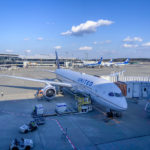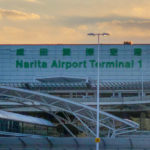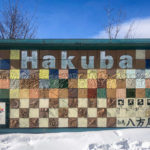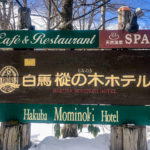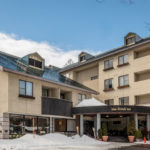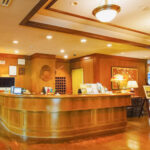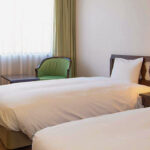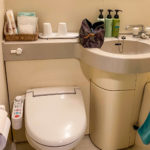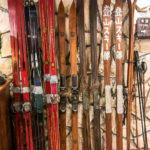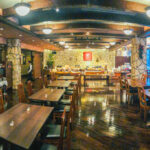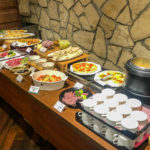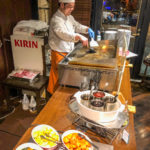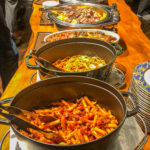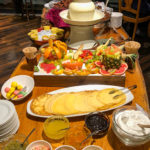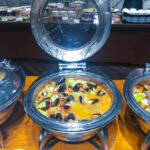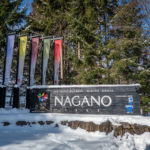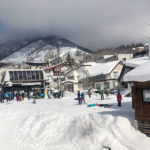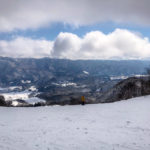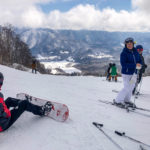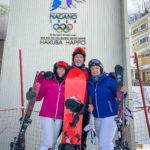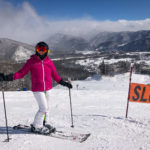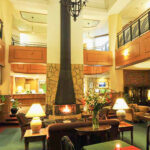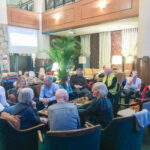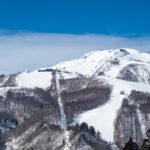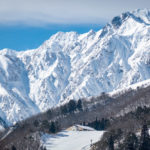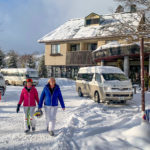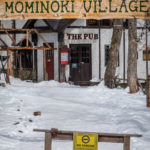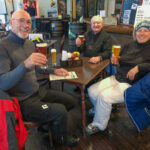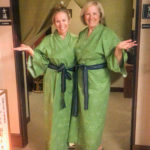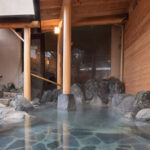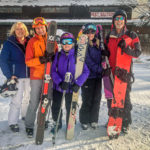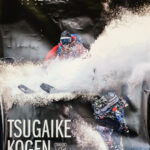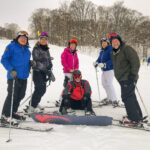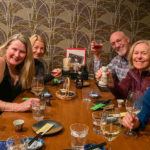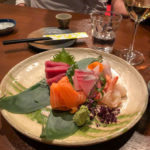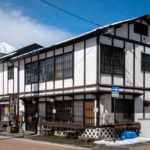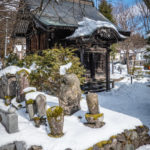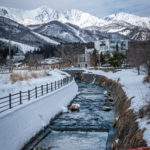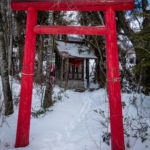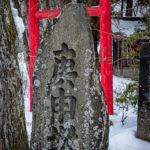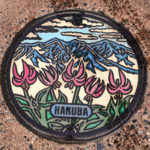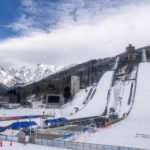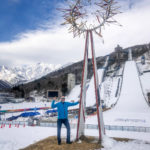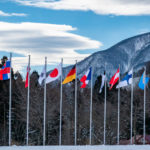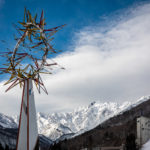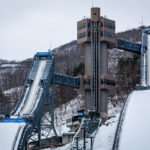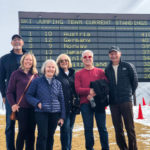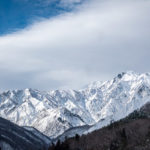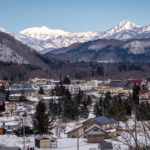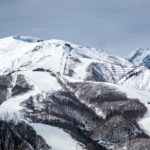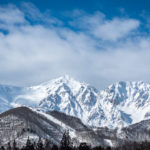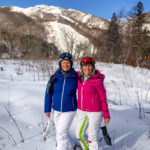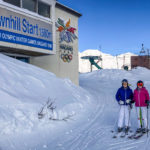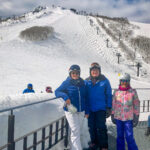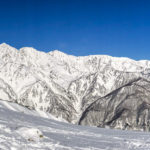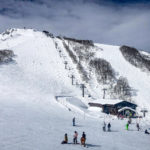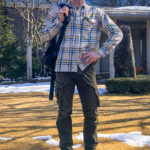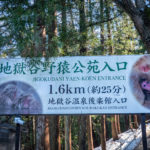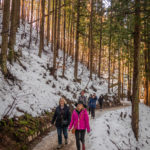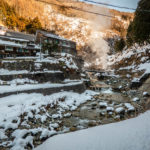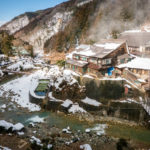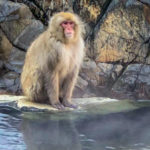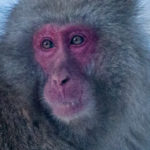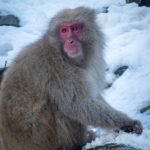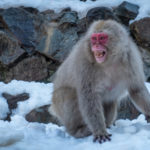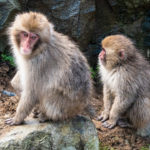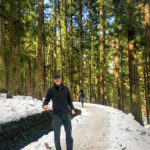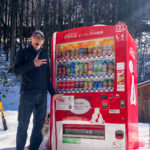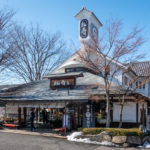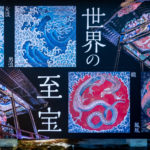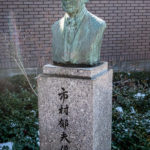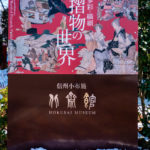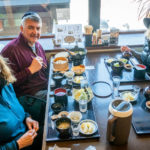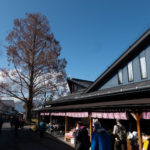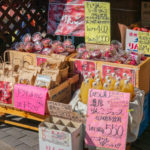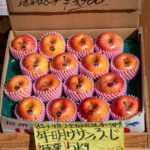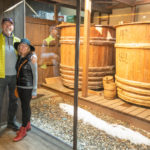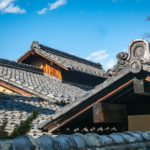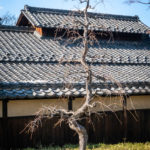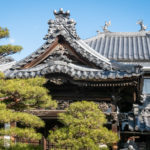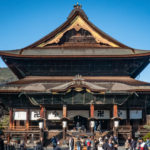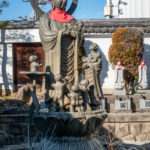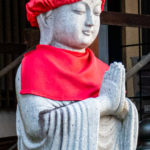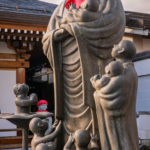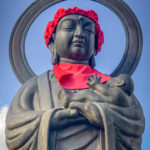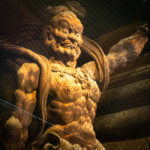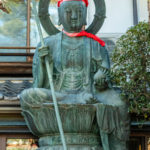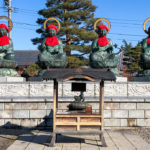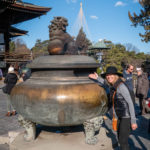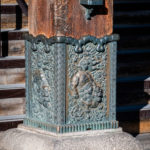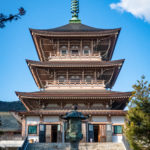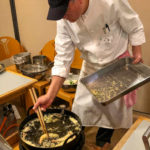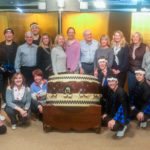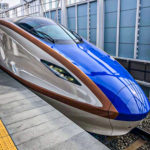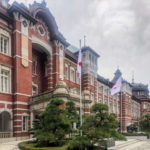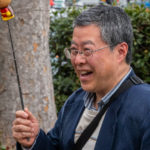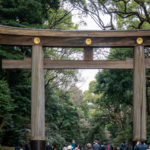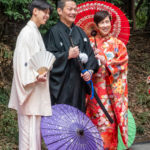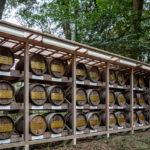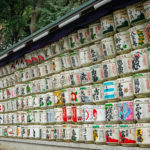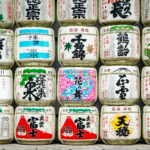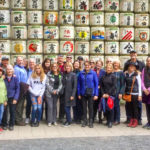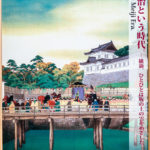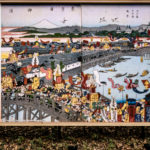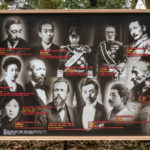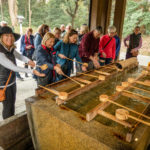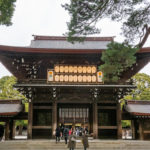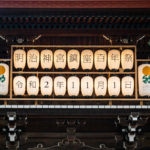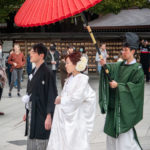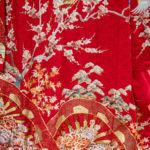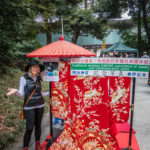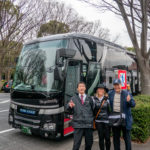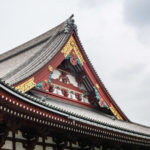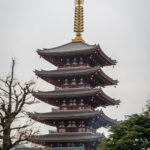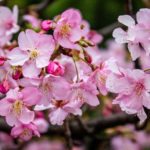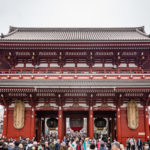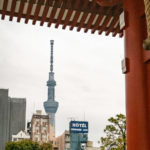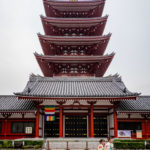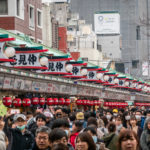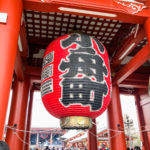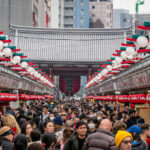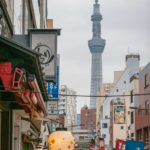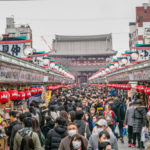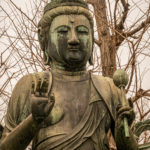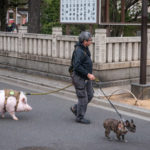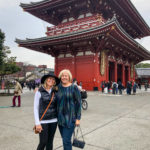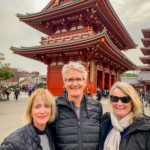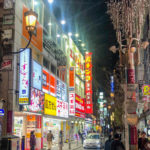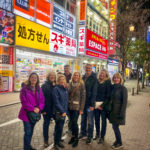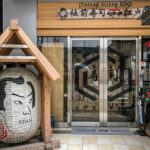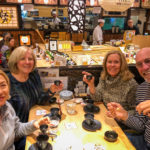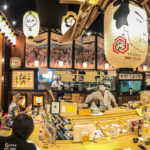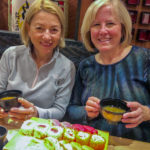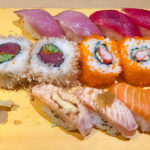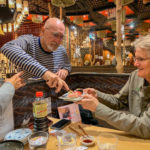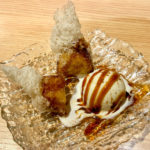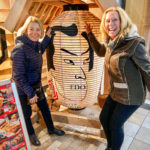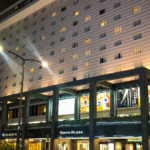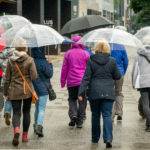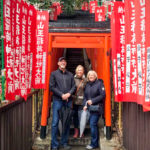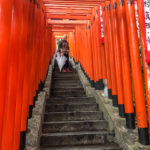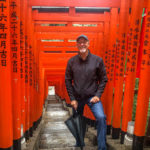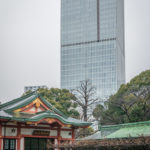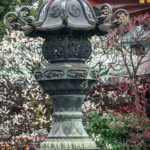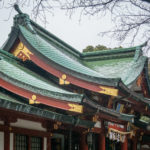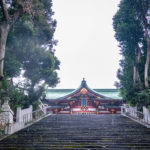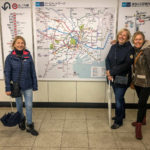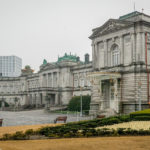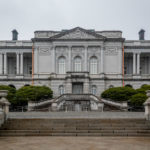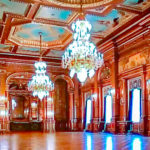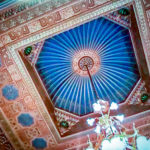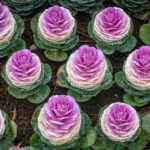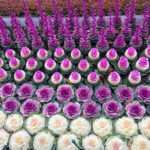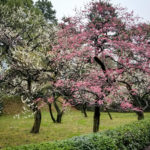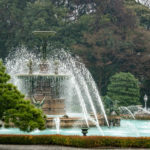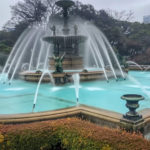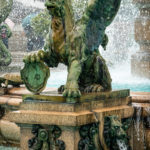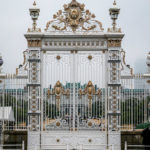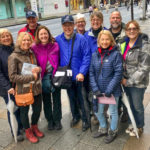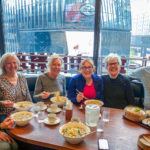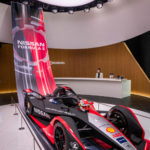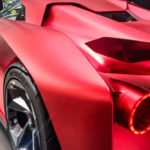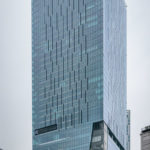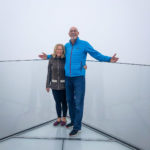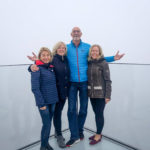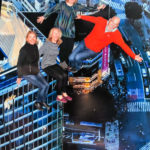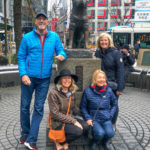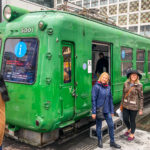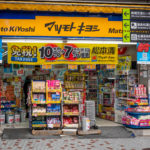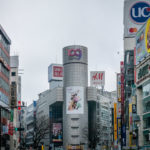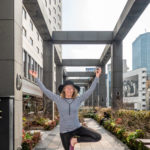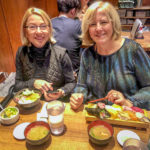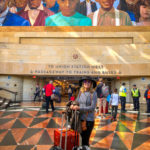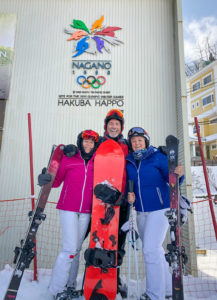 On Friday, February 7th, we were ready for our trip to Japan, for 10 days of skiing/snowboarding and sightseeing with our ski club from Ohio, the Chagrin Valley Ski Club. Kevin picked us up bright and early to drive us to Los Angeles to catch our 10:40 am flight to Tokyo. When we arrived at the Narita Airport in Tokyo the Club members were there to meet us, especially Karen Moyer (but sadly no Bruce), and we all boarded a bus for the 6 hour drive, 270km northwest of Tokyo, to Hakuba. The town of Hakuba is located 44km west of Nagano in the Nagano Prefecture, on the island of Honshu (the main island of Japan). “Hakuba Valley” is the large area that encompasses 9 ski resorts, 135 lifts, over 200 runs and various villages. Happo One Ski Resort and the Happo Village is the most popular area, and we stayed at the Hakuba Mominoki Hotel, located within a few minutes walk to Happo One. We checked in at the beautiful front desk and went off to find our rooms in different areas of the hotel, we had a standard room with a tiny bathroom.
On Friday, February 7th, we were ready for our trip to Japan, for 10 days of skiing/snowboarding and sightseeing with our ski club from Ohio, the Chagrin Valley Ski Club. Kevin picked us up bright and early to drive us to Los Angeles to catch our 10:40 am flight to Tokyo. When we arrived at the Narita Airport in Tokyo the Club members were there to meet us, especially Karen Moyer (but sadly no Bruce), and we all boarded a bus for the 6 hour drive, 270km northwest of Tokyo, to Hakuba. The town of Hakuba is located 44km west of Nagano in the Nagano Prefecture, on the island of Honshu (the main island of Japan). “Hakuba Valley” is the large area that encompasses 9 ski resorts, 135 lifts, over 200 runs and various villages. Happo One Ski Resort and the Happo Village is the most popular area, and we stayed at the Hakuba Mominoki Hotel, located within a few minutes walk to Happo One. We checked in at the beautiful front desk and went off to find our rooms in different areas of the hotel, we had a standard room with a tiny bathroom.
Day 1 The next morning we met for breakfast in the Shara Restaurant. The variety and selection of exquisite local food found only in Nagano, coupled with the skill of the executive chef, made for an amazing delightful epicurean experience. Then it was off to ski at Happo One (pronounced oh-neh), Hakuba’s premier resort and with a dusting of snow the night before we were able to enjoy some fresh new snow. For the 1998 Winter Olympics in Nagano, Hakuba Happoone Winter Resort hosted the alpine skiing downhill, super giant slalom, and combined slalom events. Karen, Bob and I took a photo standing in front of the Nagano Olympic sign. This resort was constructed in 1958, it receives an average snowfall of 11 metres (36 feet) per season, and is higher than all other ski resorts resulting in quality snow but leaves you exposed to the climate and weather conditions. We were fortunate to have a blue bird day and fresh snow that was desperately needed this season. The Apres ski gathering in the Mimoniki Hotel was at the Fireside Lounge and Wine Bar for Happy Hour from 4pm to 5pm, with a large fireplace and comfortable sofas, where we told stories of our day on the slopes, before heading off to dinner in the Shara Restaurant in the Mominoki Hotel. Click on thumbnail to view images
Day 2 we went to explore another ski area, called Hakuba47 which shares a lift ticket with the neighboring Goyru and Iimori resorts. It was another beautiful day skiing with Karen, Maria and Bill, Bob took the day off. At the end of the day we got lost as we took the wrong lift down the mountain to the Goyru ski area and had to call a cab to take us back to the hotel. We met up with Bob at the English-style pub The Pub Hakuba for some wonderful selection of Japanese and imported craft beer.
Day 3 we ventured out to another ski area, Tsugaike Kogen Ski Resort, a great resort for skiers and snow boarders because its wide open terrain. Back at the Hotel Karen and I were pampered at the Happo Onsen Hot Springs and Spa. The Happo Onsen which also has a name “Beauty Onsen” is a unique natural hot spring with one of the highest concentration of alkaline (ph11.34) in Japan and will make your skin smooth and silky. Hot springs with a ph11 alkalinity are rare across the globe and the quality of the high-temperature water makes Happo Onsen unique. In the Onsen we could relax both our body and soul (no clothes allowed) and enjoy a sauna, indoor and outdoor bath.
We took a day off from skiing to explore the town of Hakabu, nestled at the center of Hakuba Valley, the village lies in a narrow basin stretching from north to south. We visited the Hakuba Ski Jumping Stadium, built for the 1998 Olympic Games. The Hakabu Jump Stadium was completed in November 1992, taking six years since the basic design was made in 1987. We watched the ski jumpers on the course but we were not able to go up into the stadium because they were filming the story of Okabe who was a national hero because he won the Ski Jumping event at the 1998 Nagano Olympics. We went for lunch at the Maeda Restaurant, a soba noodle shop, where I had a delicious udon noodle soup with wild plants!!!
Day 3 Our final day of skiing we went back to Happo One and enjoyed a fabulous blue bird day on the slopes. We saw the starting gate for the downhill skiing at the 1998 Nagano Olympics, 1,680 metres long downhill race. My ski buddies, Karen, Maria and Bill, skied all day together stopping only for a lunch break. What a great day to end our time skiing in Japan. Click on thumbnail to view images
Hakuba
Day 4 Snow Monkey Park, Zenko-ji Temple & Drummer Show Tour
On February 13, the Ski Club went on a bus tour of the Snow Monkey Park, a tour of the Zenko-ji Temple and ended the evening at the Drummer dinner show. Our first stop was the Jigokudani Monkey Park, located in Yamanouchi, Nagano Prefecture, a part of the Joshinetsu Kogen National Park. The name Jigokudani, meaning “Hell’s Valley”, is due to its steep mountains and the smell of sulphur emitting from the natural hot springs that bubble to the surface in the valley. The Park created in 1964, is famous for its large population of wild Japanese macaques, and was established as a conservation area in which the snow monkeys would have a refuge as they descend from the steep cliffs and forest to sit in the warm waters of the onsen. We walked along the 1.2 mile footpath to view the snow monkeys in the onsen (hotsprings). The troop of macaques that come into the park is wild and free to come and go as it pleases. The Monkey Park was created because in the beginning the snow monkeys learned from watching humans soaking in the Onsen of the guesthouse called Korakukan, and the macaques copied the behavior themselves. There were serious ramifications for the guesthouse, particularly the hygiene of the water for their guests. Thus there was a movement to establish the monkey park, and daily practice of feeding the monkeys raw barley and soy beans began as an incentive to keep them in the park and away from the villages and guesthouse. Opened in 1864, Jigokudani Onsen Korkukan lies in front of Snow Monkey Park, still in operation today where guests may share their outdoor hot spring bath with the snow monkeys. We spent a long time observing the behavior of the snow monkeys in and out of the hot springs. The babies were especially playful and ran around the area chasing each other. All macaque social groups are matriarchal, arranged around dominant females, thus the very young monkeys clung onto their mothers. The snow monkeys live for 20-25 years. Then we went to Obuse to have an authentic Japanese lunch. Obuse is in central Japan and is famous for its chestnuts. Click on thumbnail to view images
Next we visited the Zenko-ji Temple, “Temple of the Benevolent”, a Buddist temple, built in the 7th century and stores the first Buddhist statue ever to be brought into Japan. The original statue is hidden while a copy of it is shown to the public every six years. The modern city of Nagano began as a town built around the temple. Some of us were brave enough to enter the dark inner chamber, an underground passage, down a narrow staircase leading to a completely dark corridor in search of the “key to paradise”. In the corridor you try to touch a metal key hanging on the wall, in order to gain enlightenment. We were all able to touch the key but no photos were allowed in the Main Hall for proof of our enlightenment. The key represents the Key to the Western Paradise of the Amida Buddha. The Zenko-ji compound contains many interesting and historically significant buildings. We all stopped at the incense burner in front of Zenko-ji Main Hall to rub the incense smoke on our bodies for good health and fortune. The Rokujizo are statues of the six Bodhisattvas, who give Buddhist enlightenment, in order to provide salvation to others. They are said to commune with six realms of hell, starvation, beasts, carnage, human beings, and divine beings. The Temple of Zenko-ji is a great pilgrimage shrine, which is visited by several million pilgrims each year. It was an honor and a once-in-a-life-time experience to be able to visit this Temple on our tour today.
A wonderful evening at the Goryu Ski area, inside the Escal Plaza, experiencing the electrifying taiko drumming and Japanese food buffet was a great way to end our day. Taiko drumming which dates back to at least the 6th century is an enormously physical endeavor. We watched in awe and amazement as all the players male and female, drumming to an an ear-splitting crescendo, their faces contort and eyes bulge with effort, with each performance. Then it was our turn to try!!! Click on thumbnail to view images
Tokyo
On February 15th we left Hakuba to take the bullet train from Nagano to Tokyo. The Shinkansen, known as the Bullet Train, is a network of high-speed railway lines in Japan. Over the Shinkansen’s 50-plus-year history, there has not been a single passenger fatality or injury due to train accidents, that’s over 10 billion passengers. So I felt very safe boarding the bullet train to Tokyo reaching a speed of 150-200 mph. The Tokyo Station where we arrived , 1 1/2 hours later, opened on December 20, 1914. We boarded our tour bus to go to the Meiji Shrine in Shibuya, Tokyo. The Meiji Shrine, a Shinto shrine, is dedicated to the deified spirits of Emperor Meiji (the first emperor of modern Japan) and his wife, Empress Shoken. We entered through the large wooden torii gate marking the entrance to Meiji Shrine, and walked down the wide graveled path leading to the main shrine building. Shaded by large trees and thick foliage it was a beautiful peaceful setting. This forest began with 100,000 trees, donated from all across Japan, commemorating Emperor Meiji, Empress Shoken and the virtues they represent. We soon arrived at a long wall of sake barrels, stacked on top of each other and wrapped in straw. Each year, these barrels are offered as a token of respect to the enshrined deities of Emperor Meiji and Empress Shoken. We spent some time here taking a group photo and admiring the unique design of each barrel. Soon we had a glimpse of the Meiji Shrine through the trees. Constructed mostly from Japanese cypress, so that the shrine blended harmoniously with its surroundings. We passed through another smaller torii, and entered into the shrine. This Meiji Shrine was reconstructed in 1958 after the original shrine (from 1920) was destroyed in WW II, and looks authentic. We were fortunate to be there when a Shinto wedding passed in front of the Shrine. We took part in a typical Shinto activity of cleansing our hands before entering the shrine. Click on thumbnail to view images
We returned to our bus and went to our next sightseeing tour of the Asakusa, a district with an atmosphere of old Tokyo. We walked around the open area exploring the many unique buildings. The Senso-ji Temple (Senso is another word for Asakusa and ‘ji” means temple) is Tokyo’s most famous and popular temple. Built in the 7th century, it is also one of the oldest. The Asakusa Shrine, also known as the Sanja-sama, survived the air raids of 1945. Another sacred building is the Hozomon, Treasure-House Gate, the inner of two large entrance gates that ultimately lead to the Senso-ji. Adjacent to the Senso-ji Temple is a five-story pagoda, the Asakusa Shinto Shrine, as well as many shops with traditional goods called the Nakamise Shopping Street. It is lined by more than 50 shops, which offer local specialities and souvenirs. We had fun sampling some of the local cuisine and buying souvenirs to take home. That evening we went to a fabulous Japanese restaurant called Itamae Sushi Edo with Karen, Maria, Bruce and Kim. The sushi was amazing and the sake presentation was the best we have tasted. Click on thumbnail to view images
The next day we went on a walking tour to the Hie Shrine, the Akasaka State Palace and the Ginza District. Our first visit was to see the Hie Jinja (Shrine), one of the major shrines of Tokyo. The shrine is located on a tree covered hilltop. The highlight is the shrines back entrance with the path lined by 90 red torii gates. After entering the big black shrine gate from the street, we arrived at the Red Torii Gate Tunnel, famous for the spot for “Enumusubi” meaning Love Knot, Marriage Tie and Safe Delivery to come true. We climbed the stairs up through the 90 red torii gates and found good luck at the top. Once at the Main Shrine we learned how to worship at the shrine: first of all, make a bow and then throw the money in the offertory box and then, 1. Bow twice, 2. Softly clap your hands twice and 3. Make another bow deeply. Then it was on to the Akasaka Palace, built in 1899-1909 in the neo-Baroque style, and was originally built as the Imperial Palace for the Crown Prince. Today the palace is designated by the Government of Japan as an official accommodation for visiting state dignitaries. In 2009 the palace was designated as a National Treasure of Japan. We toured through many of the magnificent rooms inside the Palace. Then we walked around the beautiful gardens and the fountain and out the original front gates from 1909. We walked to the Ginza District, one of the city’s top shopping districts, where we stopped for lunch overlooking the Ginza shops. Click on thumbnail to view images
Our last day in Tokyo we spent the morning exploring the Shibuya Scramble Square, a new Tokyo Landmark in Shibuya. We ventured out and took the subway there. Shibuya Scramble Square, a 230-meter tower overlooking the famous Shibuya Scramble Crossing, opened November 1, 2019, comprising of shops, restaurants and offices. The highlight is the Shibuya Sky, where we entered an elevator featuring installations on the ceiling to take us to the Sky Stage offering an unobstructed 360-degree view of Tokyo. However, we could not see anything due to the fog surrounding the building. We did get a photo taken of the four of us hanging out over the edge of the building. We had one more lunch in Tokyo before heading to the Airport and back to the USA. What a fabulous trip of a lifetime skiing and visiting Japan.


